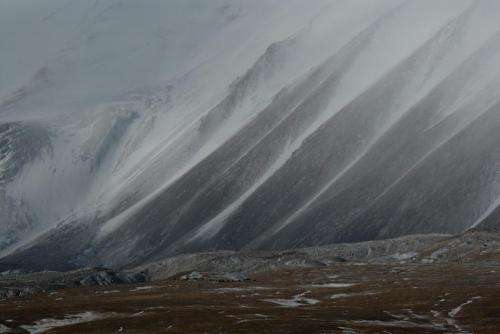Wild yaks: Shaggy barometers of climate change

A new study led by WCS (Wildlife Conservation Society), University of Montana, Qinghai Forestry Bureau, Keke Xili National Nature Reserve, and other groups finds that climate change and past hunting in the remote Tibetan Plateau is forcing female wild yaks onto steeper and steeper terrain.
Why? The authors say the key answer is snow, which females need for milk production to nurture their offspring. As the region warms - estimated at two-to-three-times faster than other parts of the planet - snow patches become more and more restricted often in steep post-glacial terrain.
Wild yaks are endangered and serve as living totems for the rugged Tibetan Plateau and the human cultures that live on the "roof of the world."
The authors of the study, which appears in the March 2nd issue of the journal Scientific Reports, include: Joel Berger of the University of Montana and WCS; George Schaller of Panthera; Ellen Cheng of Ugyen Wangchuck Institute for Conservation and Environment; Aili Kang and Lishu Li of WCS; and Michal Krebs and Mark Hebblewhite of the University of Montana.
While many scientists concerned with life at the planet's edge use models to predict future change, the research team led by Dr. Joel Berger conducted ground-based field work during winter in the Keke Xili National Nature Reserve on the Tibetan Plateau. Camping in temperatures as cold as negative 24 degrees Fahrenheit when water is totally frozen and therefore unavailable to wildlife, the team found female yaks were 20 times more likely to be found adjacent to snow patches than male yaks.
In addition, the team analyzed observations of wild yaks extracted from some 60 expeditions of the Tibetan Plateau region from 1850-1925 - travels that included British, French, Swedish, German, Russian, and American explorers. Following these expeditions, wild yaks were widely slaughtered by poachers. Comparing historical records with recent data, the authors found that male and female wild yaks used similar habitat prior to the heavy poaching pressure that began in the 1930s. However, following this spike in hunting, females shifted to areas of steeper inclines suggesting greater sensitivity to hunting and a need to protect their offspring.
"What happens in the Keke Xili National Nature Reserve can provide valuable lessons as conservation planners prepare for similar climate change impact in other parts of the world," said lead author Joel Berger of WCS and the University of Montana. "The twin findings - that the sexes of a cold-adapted species respond differently to modern climate change and long-past exploitation - indicate that effective conservation planning will require knowledge of the interplay between past and future if we will assure persistence of the region's biodiversity."
More information: Scientific Reports, www.nature.com/srep/2015/15030 … /full/srep08676.html
Journal information: Scientific Reports
Provided by Wildlife Conservation Society



















